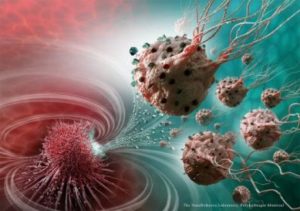New research out of the McGill University in Montreal, as well as Montreal University, has demonstrated that scientists have created microscopic nanorobots that can directly target cancer cells in the body with drugs that will destroy the cells. The nanorobots get to the cancer cells through the patients bloodstream.
The nanorobots can deliver the drugs and destroy the cancer cells without damaging healthy cells, tissue, or organs. The drugs they are using are, generally, extremely toxic to humans but the scientists believe that dosages can be made smaller because the tiny nanobots are so efficient at targeting specific areas and cells. The research teams performed the nanorobot experiments on mice.
Lead researcher on the project, Professor Sylvain Martel, said that, “These legions of nanorobotic agents were actually composed of more than 100 million flagellated bacteria, and therefore self propelled, and loaded with drugs, that moved by taking the most direct path between the drugs injection point and the area of the body to cure. The drug’s propelling force was enough to travel efficiently and enter deep inside the tumors.”
The nanorobots seek out what are known a hypoxic zones. These are where the cancer cells are located and the nanorobots can find them rather easily because these cells contain no oxygen. The cancer tumor cells eat the oxygen to survive as they replicate and destroy the healthy cells around them. These hypoxic zones, scientists say, are mostly resistant to most treatments including radiotherapy.
While the procedure was hardly an easy thing to accomplish, Martel and the researchers used nanotechnology to assist in getting it done successfully. The nano particles are manipulated so that they move toward a magnetic field within the body. The nanoparticles are magnetized with an oxygen sensor that allows them to navigate to the oxygen depleted cancer cells with the help of a computer generated magnetic field.
Martel concludes that, “This innovative use of nanotransporters will have an impact not only on creating more advanced engineering concepts and original intervention methods, but it also throws the door wide open to the synthesis of new vehicles for therapeutic, imaging and diagnostic agents. Chemotherapy, which is so toxic to the entire human body, could make use of these natural nanorobots to move drugs directly to the targeted area, eliminating the harmful side effects while also boosting its therapeutic effectiveness.”
PHOTO CREDIT: McGill University

